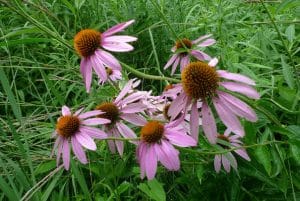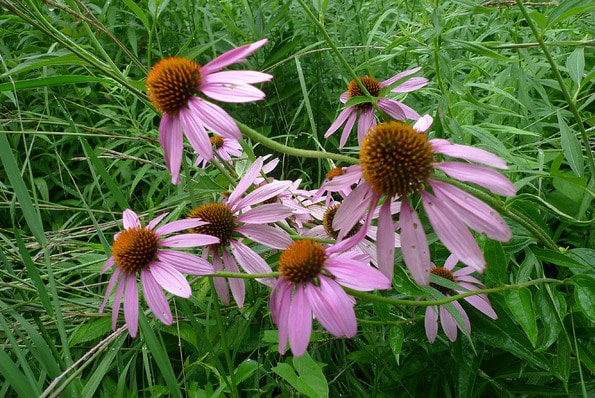Stormwater is water that used to soak into the ground and become ground water prior to development but runs off of impervious surfaces, collecting pollutants until it ultimately enters our surface waters. These pollutants include trash, chemicals, sediment, and oils among many others. Population growth and development rates are increasing the amount of pollutions and the volume and rate of runoff from impervious surfaces. Stormwater runoff pollution causes changes in hydrology and water quality that then result in habitat modifications, increased flooding, decreased aquatic biological diversity, and increased sedimentation and erosion. Best management practices (BMPs) filter out pollutants and/or prevent pollution by controlling it at its source.
Native plants ar e those plants that evolved naturally to live in a particular region, like northeast Ohio. This natural evolution process makes native plants the best suited vegetation for local conditions. In contrast, invasive plant species are non-native and commonly introduced by humans through gardening practices or accidental transportation. Invasive species can escape cultivation and reproduce in the wild, eventually outcompeting and replacing less established native plant communities. Some invasive plant species have few, if any, predators in a region and fast expansion rates. These factors make invasive plants difficult to eradicate once they’ve spread to an area. Therefore, the best defense against these pesky invasive species is to stop introducing them to our environment by planting native species instead.
e those plants that evolved naturally to live in a particular region, like northeast Ohio. This natural evolution process makes native plants the best suited vegetation for local conditions. In contrast, invasive plant species are non-native and commonly introduced by humans through gardening practices or accidental transportation. Invasive species can escape cultivation and reproduce in the wild, eventually outcompeting and replacing less established native plant communities. Some invasive plant species have few, if any, predators in a region and fast expansion rates. These factors make invasive plants difficult to eradicate once they’ve spread to an area. Therefore, the best defense against these pesky invasive species is to stop introducing them to our environment by planting native species instead.
Because native plants are adapted to the local environment, they provide many benefits to property owners. Native plants often exhibit greater survivorship rates when planted. These plants are already suited to survive the precipitation and temperature regimes in the area, which reduces the amount of stress the plants will be under throughout the year. In addition, these increased survival rates result in less replacement and maintenance than non-native species. This can produce cost savings for property owners! Native plants also require little or no irrigation, fertilizer, or pesticides, further saving property owners money. Many people purchase non-native plants for their aesthetic and ornamental appeal, but native plant species can often be very attractive as well. Aesthetically appealing native plants are used for public acceptance of stormwater BMPs, and they provide a number of property value benefits as well.
Native plants also offer many environmental benefits. Animals rely on native plants for habitats or food that invasive species cannot provide and limit the availability of. Plants also conduct evapotranspiration to return water to the atmosphere. Native plants take nutrients into their tissues, and their roots serve as substrate for bacteria and algae. This is important for nutrient cycling and organic degradation. Native plants also increase soil strength and stability. The deep roots of these plants prevent the compaction of soil, allowing air to penetrate deeper into the soil and improving water infiltration. Finally, native plants help intercept, treat, and absorb stormwater runoff. This runoff contains many pollutants that can be kept out of local waterways just by the presence of native plant communities.
The next time you choose plants, choose native. Before planting native plants, eradicate the invasive plant species in your lawn or garden. Then, to prevent the return of invasive plants, cover the area with newspaper to block light required for plant growth. Then, add soil and plant your new native plants on top.

